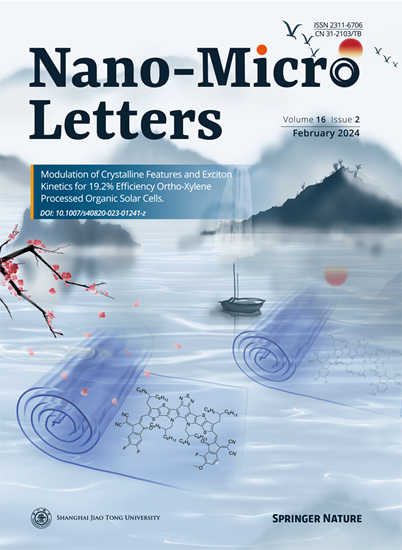Heteroatoms Synergistic Anchoring Vacancies in Phosphorus-Doped CoSe2 Enable Ultrahigh Activity and Stability in Li-S Batteries.
IF 36.3
1区 材料科学
Q1 Engineering
引用次数: 0
Abstract
Electrocatalyst activity and stability demonstrate a "seesaw" relationship. Introducing vacancies (Vo) enhances the activity by improving reactant affinity and increasing accessible active sites. However, deficient or excessive Vo reduces polysulfide adsorption and lowers catalytic stability. Herein, a novel "heteroatoms synergistic anchoring vacancies" strategy is proposed to address the trade-off between high activity and stability. Phosphorus-doped CoSe2 with remained rich selenium vacancies (P-CS-Vo-0.5) was synthesized by producing abundant selenium Vo followed by controlled P atom doping. Atomic-scale microstructure analysis elucidated a dynamic process of surface vacancy generation and the subsequent partial occupation of these vacancies by P atoms. Density functional theory simulations and in situ Raman tests revealed that the Se vacancies provide highly active catalytic sites, accelerating polysulfide conversion, while P incorporation effectively reduces the surface energy of Se vacancies and suppresses their inward migration, enhancing structural robustness. The battery with the optimal P-CS-Vo-0.5 separator delivers an initial discharge capacity of 1306.7 mAh g-1 at 0.2C, and maintain 5.04 mAh cm-2 at a high sulfur loading (5.7 mg cm-2, 5.0 μL mg-1), achieving 95.1% capacity retention after 80 cycles. This strategy of modifying local atomic environments offers a new route to designing highly active and stable catalysts.磷掺杂CoSe2的杂原子协同锚定空位使Li-S电池具有超高的活性和稳定性。
电催化剂的活性和稳定性表现出“跷跷板”关系。引入空位(Vo)通过改善反应物亲和力和增加可达活性位点来增强活性。然而,缺乏或过量的Vo会降低多硫化物的吸附,降低催化稳定性。本文提出了一种新的“杂原子协同锚定空位”策略,以解决高活性和稳定性之间的权衡。通过制备丰富的Vo硒,然后控制P原子掺杂,合成了具有丰富硒空位的磷掺杂CoSe2 (P- cs -Vo-0.5)。原子尺度的微观结构分析阐明了表面空位生成和随后P原子部分占据这些空位的动态过程。密度泛函理论模拟和原位拉曼实验表明,Se空位提供了高活性的催化位点,加速了多硫化物的转化,而P的加入有效地降低了Se空位的表面能,抑制了它们的向内迁移,增强了结构的鲁棒性。采用最佳P-CS-Vo-0.5隔板的电池在0.2C下的初始放电容量为1306.7 mAh g-1,在高硫负荷(5.7 mg cm-2, 5.0 μL mg-1)下保持5.04 mAh cm-2, 80次循环后容量保持率为95.1%。这种改变局部原子环境的策略为设计高活性和稳定的催化剂提供了一条新的途径。
本文章由计算机程序翻译,如有差异,请以英文原文为准。
求助全文
约1分钟内获得全文
求助全文
来源期刊

Nano-Micro Letters
NANOSCIENCE & NANOTECHNOLOGY-MATERIALS SCIENCE, MULTIDISCIPLINARY
CiteScore
32.60
自引率
4.90%
发文量
981
审稿时长
1.1 months
期刊介绍:
Nano-Micro Letters is a peer-reviewed, international, interdisciplinary, and open-access journal published under the SpringerOpen brand.
Nano-Micro Letters focuses on the science, experiments, engineering, technologies, and applications of nano- or microscale structures and systems in various fields such as physics, chemistry, biology, material science, and pharmacy.It also explores the expanding interfaces between these fields.
Nano-Micro Letters particularly emphasizes the bottom-up approach in the length scale from nano to micro. This approach is crucial for achieving industrial applications in nanotechnology, as it involves the assembly, modification, and control of nanostructures on a microscale.
 求助内容:
求助内容: 应助结果提醒方式:
应助结果提醒方式:


